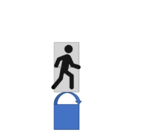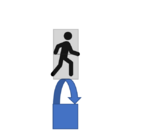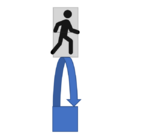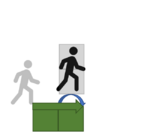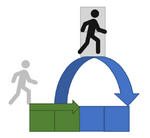Difference between revisions of "Actions"
m (Occupant moved page Player Actions to Actions without leaving a redirect) |
|||
| (83 intermediate revisions by the same user not shown) | |||
| Line 1: | Line 1: | ||
[[Main Page]] > [[Rules]] > [[Adventuring]] > [[Actions]] | |||
=Movement Actions= | =Movement Actions= | ||
| Line 36: | Line 38: | ||
* '''Cost''': 2 Movement | * '''Cost''': 2 Movement | ||
* '''Effect''': Jump 1m straight up air, plus 1m if your Might or Agility is 6 or higher. | * '''Effect''': Jump 1m straight up air, plus 1m if your Might or Agility is 6 or higher, minus 1m if your Might or Agility is 2 or lower. | ||
** The jump includes an optional horizontal equal to the height of the jump if starting with a run of 2m of more. | |||
** The run distance and jump height are both modified by [[Size]] Multiplier. | |||
** A creature that can jump at all is always able to jump as high as ¼ their height. | |||
** Examples are in Tables 1 and 2, below. | |||
{| class="wikitable" | |||
|+ Table 1. High Jump Distances | |||
|- | |||
! Start !! Might/Agility !! Tiny Height !! Small Height !! Medium Height !! Large Height !! Huge Height !! Gargantuan Height | |||
|- | |||
| 0m (Standing) || < 2 || 0m || 0m || 0m || 1m || 2m || 4m | |||
|- | |||
| 0m (Standing) || Normal || 0m || 1m || 1m || 2m || 4m || 8m | |||
|- | |||
| 0m (Standing) || > 6 || 1m || 1m || 2m || 4m || 8m || 16m | |||
|- | |||
| 2m (Running) || < 2 || 0m || 0m || 0m || 1m / 1m || 2m / 2m || 4m / 4m | |||
|- | |||
| 2m (Running) || Normal || 0m || 1m / 1m || 1m / 1m || 2m / 2m || 4m / 4m || 8m / 8m | |||
|- | |||
| 2m (Running) || > 6 || 1m / 1m || 1m / 1m || 2m / 2m || 4m / 4m || 8m / 8m || 16m / 16m | |||
|} | |||
{| class="wikitable" | |||
|+ Table 2. High Jump Diagrams | |||
|- | |||
! Start !! Score < 2 !! Score Normal !! Score > 6 | |||
|- | |||
| Standing || [[File:high_stand_weak.png|none|150px]] || [[File:high_stand_normal.png|none|150px]] || [[File:high_stand_athlete.png|none|150px]] | |||
|- | |||
| 2m Run || [[File:high_jog_weak.png|none|150px]] || [[File:high_jog_normal.png|none|150px]] || [[File:high_jog_athlete.png|none|150px]] | |||
|} | |||
==Long Jump== | ==Long Jump== | ||
* '''Cost''': | * '''Cost''': 4 Movement | ||
* '''Effect''': Jump 2m horizontally, plus 1m if your Might or Agility is 6 or higher. The distance is doubled if you run 2m before jumping. The distance is tripled if you run 4m before jumping. Landing on rough or slippery terrain may require an Agility check to avoid falling prone. Examples are in | * '''Effect''': Jump 2m horizontally, plus 1m if your Might or Agility is 6 or higher, minus 1m if your Might or Agility is 2 or lower. | ||
** The distance is doubled if you run 2m before jumping. | |||
** The distance is tripled if you run 4m before jumping. | |||
** Movement is reduced to zero for the current turn when after landing a running long jump. | |||
** Landing on rough or slippery terrain may require an Agility check to avoid falling prone. | |||
** The jump includes clearing a maximum height of ¼ the jump distance. | |||
** The running distance and jump distance are both modified by [[Size]] Multiplier. | |||
** Examples are in Tables 3 and 4, below. | |||
{| class="wikitable" | {| class="wikitable" | ||
|+ Table | |+ Table 3. Long Jumping Distances | ||
|- | |- | ||
! Start !! Score | ! Start !! Score !! Tiny Distance !! Small Distance !! Medium Distance !! Large Distance !! Huge Distance !! Gargantuan Distance | ||
|- | |- | ||
| 0m (Standing) || | | 0m (Standing) || < 2 || 0m || 1m || 1m || 2m || 4m || 8m | ||
|- | |- | ||
| 0m (Standing) || | | 0m (Standing) || Normal || 1m || 1m || 2m || 4m || 8m || 16m | ||
|- | |- | ||
| | | 0m (Standing) || > 6 || 1m || 2m || 3m || 6m || 12m || 24m | ||
|- | |- | ||
| 2m (Running) || | | 2m (Running) || < 2 || 1m || 1m || 2m || 4m || 8m || 16m | ||
|- | |- | ||
| | | 2m (Running) || Normal || 1m || 2m || 4m || 8m || 16m || 32m | ||
|- | |- | ||
| 4m (Running) || | | 2m (Running) || > 6 || 2m || 3m || 6m || 12m || 24m || 48m | ||
|- | |||
| 4m (Running) || < 2 || 1m || 2m || 3m || 6m || 12m || 24m | |||
|- | |||
| 4m (Running) || Normal || 2m || 3m || 6m || 12m || 24m || 48m | |||
|- | |||
| 4m (Running) || > 6 || 2m || 5m || 9m || 18m || 36m || 72m | |||
|} | |} | ||
{| class="wikitable" | |||
|+ Table 4. Long Jump Diagrams (Medium Size) | |||
|- | |||
! Start !! Score < 2 !! Score Normal !! Score > 6 | |||
|- | |||
| Standing || [[File:long_stand_weak.png|none|300px]] || [[File:long_stand_normal.png|none|300px]] || [[File:long_stand_athlete.png|none|300px]] | |||
|- | |||
| 2m Run|| [[File:long_jog_weak.png|none|300px]] || [[File:long_jog_normal.png|none|300px]] || [[File:long_jog_athlete.png|none|300px]] | |||
|- | |||
| 4m Run || [[File:long_run_weak.png|none|300px]] || [[File:long_run_normal.png|none|300px]] || [[File:long_run_athlete.png|none|300px]] | |||
|} | |||
==Difficult Terrain== | |||
* '''Cost''': +1 Movement per Difficulty Rating | |||
* '''Effect''': Move a distance of 1m. Only affects Run, Swim, Climb, or Crawl movement through difficult terrain. If Movement cost exceeds base Speed, the terrain is impassable. | |||
==Grappled Move== | |||
* '''Cost''': Special | |||
* '''Effect''': While grappling a creature, the grappler's Speed is halved. | |||
=Standard Actions= | =Standard Actions= | ||
Each turn you get a single Standard Action that defines most of what you can do in a turn of combat. | |||
==Attack== | |||
A single Attack action usually involves making a single Attack roll with a wielded weapon. | |||
{{Apparatus_AttackRoll}} | |||
Some common things that can affect the Attack action: | |||
===Advantage=== | |||
* Dual-wielding weapons grants +Advantage on the Attack roll. | |||
* Attacks while [[Unseen]] have +Advantage. | |||
* Attacks against [[Obscured]] targets have -Advantage. | |||
* Attacks while [[Frightened]] have -Advantage. | |||
* Attacks while [[Poisoned]] have -Advantage. | |||
* Attacks while [[Prone]] have -Advantage. | |||
** Melee Attacks against a [[Prone]] target have +Advantage. | |||
** Ranged Attacks against a [[Prone]] target have -Advantage. | |||
* Attacks while [[Restrained]] have -Advantage. | |||
** Attacks against a [[Restrained]] target have +Advantage. | |||
* Attacks with [[Exhaustion]] 3 or higher have -Advantage. | |||
* Ranged Attacks while adjacent to a hostile enemy have -Advantage. | |||
* Ranged Attacks at Far Range have -Advantage. | |||
* Attacks with +3 Advantage or more automatically succeed. | |||
* Attacks with -3 Advantage or less automatically fail. | |||
===Critical Hits=== | |||
* Rolling equal to or greater than the [[Critical Threshold]] on the Attack roll results in a critical hit. | |||
** A critical hit deals additional damage equal to the maximum value of the largest damage die used in the Attack. | |||
** If the Attack roll for a critical hit would normally miss the target, the attack still hits but deals normal damage instead. | |||
* Attacks against [[Incapacitated]] targets are automatically Critical Hits. | |||
===Barred Attacks=== | |||
* You cannot Attack an [[Unseen]] target without some clue to the target's location. Getting a sense of the target's location makes the target [[Obscured]] instead of Unseen. | |||
* If you are subject to [[Charm]], you cannot attack the source of the [[Charm]] effect. | |||
* You cannot Attack while [[Incapacitated]]. | |||
* You cannot perform Ranged Attacks on targets beyond Far Range. | |||
==Grapple== | |||
A Grapple is a special kind of Attack Action, with specific rules that do not apply to normal Attack Actions. | |||
===Initiate Grapple=== | |||
To start a Grapple, you must: | |||
* Be within melee range of the target | |||
* Be able to make an Attack against the target (see Attack Action, above) | |||
* Have at least one free hand | |||
* Be no more than one [[Size]] smaller than the target | |||
* Succeed at a Grapple check: | |||
<code>1d20 + Combat Proficiency + Might + Size Modifier >= Enemy Physique Rating</code> | |||
===Basic Grapple=== | |||
If the Grapple check is successful, the target is subject to a [[Basic Grapple]] condition. If the Grapple check is a critical success, the target is instead subject to an Advanced Grapple (see below). | |||
* Target's [[Speed]] becomes 0 and it can't benefit to bonuses to Speed. | |||
* Basic Grapple ends if you become [[Incapacitated]]. | |||
* Basic Grapple ends if either you or the target is moved out of your melee reach, such as by [[Forced Movement]]. | |||
* Basic Grapple ends if the target takes an Action to Escape and you fail a Grapple check to sustain the Grapple. | |||
===Advanced Grapple=== | |||
If you have a Basic Grapple with a target, they can use their Action to upgrade the Basic Grapple to an Advanced Grapple by succeeding at another Grapple Check. If the Grapple check is a critical success, the target is instead subject to a Complete Grapple (see below). The [[Advanced Grapple]] condition works like Basic Grapple, but also imposes: | |||
* Target is considered [[Restrained]]. | |||
* If you or target are subjected to [[Forced Movement]], you both are moved and the Grapple is maintained. | |||
* Advanced Grapple is downgraded to Basic Grapple if the target takes an Action to Escape and you fail a Grapple check to sustain the Grapple. | |||
===Complete Grapple=== | |||
If you have an Advanced Grapple with a target, they can use their Action to upgrade the Advanced Grapple to a Complete Grapple by succeeding at another Grapple Check. If the Grapple check is a critical success, they can also choose one Complete Grapple Stunt from the list below. The [[Complete Grapple]] condition works like Advanced Grapple, but also imposes: | |||
* Target is considered [[Incapacitated]]. | |||
You can take an Action to perform any one of the following Complete Grapple Stunts to the target of a Complete Grapple: | |||
* Prevent breathing, causing the target to asphyxiate for a turn. | |||
* Deal <code>1d6 + Might + Size Modifier</code> physical damage. | |||
While grappling a target, your Speed is halved unless the target is at least two [[Size|Sizes]] smaller than you. Moving while grappling moves the target as well. | |||
===Expert Grappler Feat=== | |||
Additional grappling options are available to characters with the [[Expert Grappler]] [[Feat]]. | |||
==Attack== | ==Shove== | ||
A Shove Action is a kind of Attack with special rules that don't apply to normal Attacks. | |||
To attempt a shove, you must: | |||
* Be within melee range of the target | |||
* Be able to make an Attack against the target (see Attack Action, above) | |||
* Be no more than one [[Size]] category smaller than the target | |||
* Succeed at a Shove check: | |||
<code>1d20 + Combat Proficiency + Might + Size Modifier >= Enemy Physique Rating</code> | |||
If successful, the target can be knocked Prone or Pushed 1m. | |||
==Dash== | |||
Using the Dash Action allows you to generate additional Movement equal to your Speed for the current turn. | |||
==Disengage== | |||
By taking the Disengage Action, your movement does not provoke Opportunity Attacks for the rest of your turn. | |||
==Evade== | ==Evade== | ||
== | By taking the Evade Action, your Defense rolls have +Advantage until the start of your next turn. You lose this benefit if you are [[Incapacitated]] or if your [[Speed]] drops to 0. | ||
==Escape== | |||
By taking an Escape Action, you can try to get out of a Grapple or other form of restraint. | |||
To Escape a Grapple, you roll: | |||
<code>1d20 + Combat Proficiency + Might/Agility + Size Modifier >= Enemy Physique Rating</code> | |||
If successful, you escape a Basic Grapple or downgrade an Advanced Grapple to a Basic Grapple. | |||
To Escape other restraints, you roll: | |||
<code>1d20 + Might/Agility >= Difficulty Rating</code> | |||
==Hide== | |||
As an Action, you can make a stealth check to become [[Unseen]]. The difficulty of the check depends on the circumstances (e.g. available cover, illumination, et cetera). | |||
==Prepare== | |||
As an Action, you can Prepare to perform another action before your next turn. Choose another action. Before your next turn you can spend your Reaction to perform the Prepared Action. | |||
=Bonus Actions= | |||
Each turn you get one Bonus Action that can be used during your turn. Unused Bonus Actions are lost at the end of your turn. | |||
== | ==Use Readied Item== | ||
As a Bonus Action, you can use any item that you have [[Readied]], such as quaffing a potion, drawing a weapon, or sheathing a weapon. | |||
=Reactions= | |||
At the end of your turn, you gain 1 Reaction until the start of your next turn. | |||
==Opportunity Attack== | |||
You can use your Reaction to make an [[Opportunity Attack]] against any creature in range that provokes an Opportunity Attack. | |||
==Prepared Action== | |||
You can use your Reaction to perform a [[#Prepare|Prepared Action]] (see above) any time before your next your turn. | |||
=Special Actions= | |||
Some actions can take the form of a Move, Standard, or Bonus action, depending on the circumstances. | |||
==Features, Spells, Items== | |||
Features, spells, and items can provide actions to characters. When actions are provided by these, the type of action will be specified in the description (i.e., Move, Standard, or Bonus). | |||
==Stunts== | |||
While the actions listed here are the most common, players are not limited to these actions. When a player wishes to take an action that is not specified in this list, and is not provided by a class feature, spell, or item, it is called a "stunt". The player and GM can negotiate what the action entails and what kind of action it is. For example, if a player wishes to swing on a rope across a chasm, it would likely be a Move action. | |||
Latest revision as of 03:47, 18 November 2022
Main Page > Rules > Adventuring > Actions
Movement Actions
Each turn you generate Movement equal to your Speed. You can spend Movement on the following actions at any time during your turn, until you do not have Movement remaining. You do not need to spend all of your Movement, but unspent Movement is lost at the end of your turn.
Run
- Cost: 1 Movement
- Effect: Run a distance of 1m.
Climb
- Cost: 2 Movement, or 1 Movement if you have the Natural Climber Feat
- Effect: Climb a distance of 1m. This distance is affected by your Size Modifier.
Swim
- Cost: 2 Movement, or 1 Movement if you have the Natural Swimmer Feat
- Effect: Swim a distance of 1m. This distance is affected by your Size Modifier.
Drop Prone
- Cost: 0 Movement
- Effect: Fall prone.
Crawl
- Cost: 2 Movement
- Effect: Crawl a distance of 1m. This distance is affected by your Size Modifier.
Stand Up
- Cost: ½ Speed
- Effect: Stand up from prone.
High Jump
- Cost: 2 Movement
- Effect: Jump 1m straight up air, plus 1m if your Might or Agility is 6 or higher, minus 1m if your Might or Agility is 2 or lower.
- The jump includes an optional horizontal equal to the height of the jump if starting with a run of 2m of more.
- The run distance and jump height are both modified by Size Multiplier.
- A creature that can jump at all is always able to jump as high as ¼ their height.
- Examples are in Tables 1 and 2, below.
| Start | Might/Agility | Tiny Height | Small Height | Medium Height | Large Height | Huge Height | Gargantuan Height |
|---|---|---|---|---|---|---|---|
| 0m (Standing) | < 2 | 0m | 0m | 0m | 1m | 2m | 4m |
| 0m (Standing) | Normal | 0m | 1m | 1m | 2m | 4m | 8m |
| 0m (Standing) | > 6 | 1m | 1m | 2m | 4m | 8m | 16m |
| 2m (Running) | < 2 | 0m | 0m | 0m | 1m / 1m | 2m / 2m | 4m / 4m |
| 2m (Running) | Normal | 0m | 1m / 1m | 1m / 1m | 2m / 2m | 4m / 4m | 8m / 8m |
| 2m (Running) | > 6 | 1m / 1m | 1m / 1m | 2m / 2m | 4m / 4m | 8m / 8m | 16m / 16m |
| Start | Score < 2 | Score Normal | Score > 6 |
|---|---|---|---|
| Standing | |||
| 2m Run |
Long Jump
- Cost: 4 Movement
- Effect: Jump 2m horizontally, plus 1m if your Might or Agility is 6 or higher, minus 1m if your Might or Agility is 2 or lower.
- The distance is doubled if you run 2m before jumping.
- The distance is tripled if you run 4m before jumping.
- Movement is reduced to zero for the current turn when after landing a running long jump.
- Landing on rough or slippery terrain may require an Agility check to avoid falling prone.
- The jump includes clearing a maximum height of ¼ the jump distance.
- The running distance and jump distance are both modified by Size Multiplier.
- Examples are in Tables 3 and 4, below.
| Start | Score | Tiny Distance | Small Distance | Medium Distance | Large Distance | Huge Distance | Gargantuan Distance |
|---|---|---|---|---|---|---|---|
| 0m (Standing) | < 2 | 0m | 1m | 1m | 2m | 4m | 8m |
| 0m (Standing) | Normal | 1m | 1m | 2m | 4m | 8m | 16m |
| 0m (Standing) | > 6 | 1m | 2m | 3m | 6m | 12m | 24m |
| 2m (Running) | < 2 | 1m | 1m | 2m | 4m | 8m | 16m |
| 2m (Running) | Normal | 1m | 2m | 4m | 8m | 16m | 32m |
| 2m (Running) | > 6 | 2m | 3m | 6m | 12m | 24m | 48m |
| 4m (Running) | < 2 | 1m | 2m | 3m | 6m | 12m | 24m |
| 4m (Running) | Normal | 2m | 3m | 6m | 12m | 24m | 48m |
| 4m (Running) | > 6 | 2m | 5m | 9m | 18m | 36m | 72m |
| Start | Score < 2 | Score Normal | Score > 6 |
|---|---|---|---|
| Standing | |||
| 2m Run | |||
| 4m Run |
Difficult Terrain
- Cost: +1 Movement per Difficulty Rating
- Effect: Move a distance of 1m. Only affects Run, Swim, Climb, or Crawl movement through difficult terrain. If Movement cost exceeds base Speed, the terrain is impassable.
Grappled Move
- Cost: Special
- Effect: While grappling a creature, the grappler's Speed is halved.
Standard Actions
Each turn you get a single Standard Action that defines most of what you can do in a turn of combat.
Attack
A single Attack action usually involves making a single Attack roll with a wielded weapon.
Some common things that can affect the Attack action:
Advantage
- Dual-wielding weapons grants +Advantage on the Attack roll.
- Attacks while Unseen have +Advantage.
- Attacks against Obscured targets have -Advantage.
- Attacks while Frightened have -Advantage.
- Attacks while Poisoned have -Advantage.
- Attacks while Prone have -Advantage.
- Attacks while Restrained have -Advantage.
- Attacks against a Restrained target have +Advantage.
- Attacks with Exhaustion 3 or higher have -Advantage.
- Ranged Attacks while adjacent to a hostile enemy have -Advantage.
- Ranged Attacks at Far Range have -Advantage.
- Attacks with +3 Advantage or more automatically succeed.
- Attacks with -3 Advantage or less automatically fail.
Critical Hits
- Rolling equal to or greater than the Critical Threshold on the Attack roll results in a critical hit.
- A critical hit deals additional damage equal to the maximum value of the largest damage die used in the Attack.
- If the Attack roll for a critical hit would normally miss the target, the attack still hits but deals normal damage instead.
- Attacks against Incapacitated targets are automatically Critical Hits.
Barred Attacks
- You cannot Attack an Unseen target without some clue to the target's location. Getting a sense of the target's location makes the target Obscured instead of Unseen.
- If you are subject to Charm, you cannot attack the source of the Charm effect.
- You cannot Attack while Incapacitated.
- You cannot perform Ranged Attacks on targets beyond Far Range.
Grapple
A Grapple is a special kind of Attack Action, with specific rules that do not apply to normal Attack Actions.
Initiate Grapple
To start a Grapple, you must:
- Be within melee range of the target
- Be able to make an Attack against the target (see Attack Action, above)
- Have at least one free hand
- Be no more than one Size smaller than the target
- Succeed at a Grapple check:
1d20 + Combat Proficiency + Might + Size Modifier >= Enemy Physique Rating
Basic Grapple
If the Grapple check is successful, the target is subject to a Basic Grapple condition. If the Grapple check is a critical success, the target is instead subject to an Advanced Grapple (see below).
- Target's Speed becomes 0 and it can't benefit to bonuses to Speed.
- Basic Grapple ends if you become Incapacitated.
- Basic Grapple ends if either you or the target is moved out of your melee reach, such as by Forced Movement.
- Basic Grapple ends if the target takes an Action to Escape and you fail a Grapple check to sustain the Grapple.
Advanced Grapple
If you have a Basic Grapple with a target, they can use their Action to upgrade the Basic Grapple to an Advanced Grapple by succeeding at another Grapple Check. If the Grapple check is a critical success, the target is instead subject to a Complete Grapple (see below). The Advanced Grapple condition works like Basic Grapple, but also imposes:
- Target is considered Restrained.
- If you or target are subjected to Forced Movement, you both are moved and the Grapple is maintained.
- Advanced Grapple is downgraded to Basic Grapple if the target takes an Action to Escape and you fail a Grapple check to sustain the Grapple.
Complete Grapple
If you have an Advanced Grapple with a target, they can use their Action to upgrade the Advanced Grapple to a Complete Grapple by succeeding at another Grapple Check. If the Grapple check is a critical success, they can also choose one Complete Grapple Stunt from the list below. The Complete Grapple condition works like Advanced Grapple, but also imposes:
- Target is considered Incapacitated.
You can take an Action to perform any one of the following Complete Grapple Stunts to the target of a Complete Grapple:
- Prevent breathing, causing the target to asphyxiate for a turn.
- Deal
1d6 + Might + Size Modifierphysical damage.
While grappling a target, your Speed is halved unless the target is at least two Sizes smaller than you. Moving while grappling moves the target as well.
Expert Grappler Feat
Additional grappling options are available to characters with the Expert Grappler Feat.
Shove
A Shove Action is a kind of Attack with special rules that don't apply to normal Attacks.
To attempt a shove, you must:
- Be within melee range of the target
- Be able to make an Attack against the target (see Attack Action, above)
- Be no more than one Size category smaller than the target
- Succeed at a Shove check:
1d20 + Combat Proficiency + Might + Size Modifier >= Enemy Physique Rating
If successful, the target can be knocked Prone or Pushed 1m.
Dash
Using the Dash Action allows you to generate additional Movement equal to your Speed for the current turn.
Disengage
By taking the Disengage Action, your movement does not provoke Opportunity Attacks for the rest of your turn.
Evade
By taking the Evade Action, your Defense rolls have +Advantage until the start of your next turn. You lose this benefit if you are Incapacitated or if your Speed drops to 0.
Escape
By taking an Escape Action, you can try to get out of a Grapple or other form of restraint.
To Escape a Grapple, you roll:
1d20 + Combat Proficiency + Might/Agility + Size Modifier >= Enemy Physique Rating
If successful, you escape a Basic Grapple or downgrade an Advanced Grapple to a Basic Grapple.
To Escape other restraints, you roll:
1d20 + Might/Agility >= Difficulty Rating
Hide
As an Action, you can make a stealth check to become Unseen. The difficulty of the check depends on the circumstances (e.g. available cover, illumination, et cetera).
Prepare
As an Action, you can Prepare to perform another action before your next turn. Choose another action. Before your next turn you can spend your Reaction to perform the Prepared Action.
Bonus Actions
Each turn you get one Bonus Action that can be used during your turn. Unused Bonus Actions are lost at the end of your turn.
Use Readied Item
As a Bonus Action, you can use any item that you have Readied, such as quaffing a potion, drawing a weapon, or sheathing a weapon.
Reactions
At the end of your turn, you gain 1 Reaction until the start of your next turn.
Opportunity Attack
You can use your Reaction to make an Opportunity Attack against any creature in range that provokes an Opportunity Attack.
Prepared Action
You can use your Reaction to perform a Prepared Action (see above) any time before your next your turn.
Special Actions
Some actions can take the form of a Move, Standard, or Bonus action, depending on the circumstances.
Features, Spells, Items
Features, spells, and items can provide actions to characters. When actions are provided by these, the type of action will be specified in the description (i.e., Move, Standard, or Bonus).
Stunts
While the actions listed here are the most common, players are not limited to these actions. When a player wishes to take an action that is not specified in this list, and is not provided by a class feature, spell, or item, it is called a "stunt". The player and GM can negotiate what the action entails and what kind of action it is. For example, if a player wishes to swing on a rope across a chasm, it would likely be a Move action.
